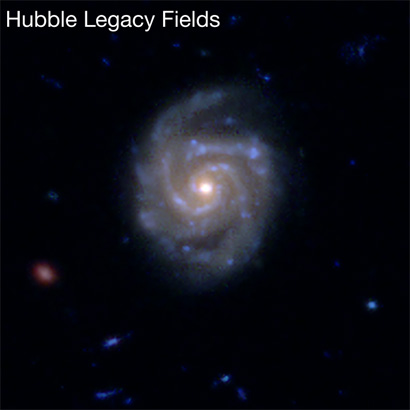May 13 2020
At UC Santa Cruz, scientists have designed a new robust computer program known as Morpheus with the ability to examine astronomical image data pixel by pixel to determine and classify all of the stars and galaxies in huge data sets from astronomy surveys.
 A Hubble Space Telescope image of a region in the Hubble Legacy Fields includes a large disk galaxy (above). The image below shows the Morpheus morphological classification results for the same region. Image Credit: NASA/STScI and Ryan Hausen.
A Hubble Space Telescope image of a region in the Hubble Legacy Fields includes a large disk galaxy (above). The image below shows the Morpheus morphological classification results for the same region. Image Credit: NASA/STScI and Ryan Hausen.
Morpheus is a deep-learning framework that includes a range of artificial intelligence technologies specially designed for applications such as speech and image recognition.
Robertson said the quickly increasing size of astronomy data sets has made it necessary to automate few tasks performed conventionally by astronomers.
There are some things we simply cannot do as humans, so we have to find ways to use computers to deal with the huge amount of data that will be coming in over the next few years from large astronomical survey projects.
Brant Robertson, Professor of Astronomy and Astrophysics, Leader of Computational Astrophysics Research Group, UC Santa Cruz
Robertson collaborated with Ryan Hausen, a computer science graduate student at UCSC’s Baskin School of Engineering, who designed and tested Morpheus over the past two years. The study results were published in the Astrophysical Journal Supplement Series on May 12th, 2020.
Hausen and Robertson are also releasing the Morpheus code openly and offering online demonstrations.
From the morphologies of galaxies, right from rotating disk galaxies such as the Milky Way to amorphous spheroidal and elliptical galaxies, astronomers can learn about the formation and evolution of galaxies.
Large-scale surveys, such as the Legacy Survey of Space and Time (LSST) to be performed at the Vera Rubin Observatory, which is now being constructed in Chile, will produce large amounts of image data, and Robertson has been engaged in planning how to make use of that data to gain insights into how galaxies form and evolve.
LSST will take over 800 panoramic images every night with a 3.2-billion-pixel camera, registering the complete visible sky twice each week.
Imagine if you went to astronomers and asked them to classify billions of objects—how could they possibly do that? Now we’ll be able to automatically classify those objects and use that information to learn about galaxy evolution.
Brant Robertson, Professor of Astronomy and Astrophysics, Leader of Computational Astrophysics Research Group, UC Santa Cruz
Although various other astronomers have employed deep-learning technology for the classification of galaxies, the earlier measures that were taken often involved adapting current image recognition algorithms, and scientists have fed curated images of the to-be-categorized galaxies to the algorithms.
Hausen developed Morpheus from scratch particularly for astronomical image data, and the model makes use of the original image data as input in the normal digital file format used by astronomers.
According to Robertson, pixel-level classification is another significant benefit of Morpheus.
With other models, you have to know something is there and feed the model an image, and it classifies the entire galaxy at once. Morpheus discovers the galaxies for you, and does it pixel by pixel, so it can handle very complicated images, where you might have a spheroidal right next to a disk. For a disk with a central bulge, it classifies the bulge separately. So it’s very powerful.
Brant Robertson, Professor of Astronomy and Astrophysics, Leader of Computational Astrophysics Research Group, UC Santa Cruz
The researchers trained the deep-learning algorithm using data from a 2015 study where several astronomers classified nearly 10,000 galaxies in Hubble Space Telescope images from the CANDELS survey.
Subsequently, they applied Morpheus to image data from the Hubble Legacy Fields, which integrates observations by various Hubble deep-field surveys.
While processing an image of a specific region of the sky, Morpheus produces a new set of images of that specific part in which all objects are color-coded according to their morphology, isolating the astronomical objects from the background and determining point sources (stars) and several kinds of galaxies.
The output contains a confidence level for every classification. When the program is run on UCSC’s lux supercomputer, it quickly produces a pixel-by-pixel analysis for the complete data set.
According to Hausen, “Morpheus provides detection and morphological classification of astronomical objects at a level of granularity that doesn’t currently exist.”
Interactive visualization of the outcomes from the Morpheus model for GOODS South, a deep-field study that captured millions of galaxies, has been released openly.
This study was financially supported by NASA and the National Science Foundation.
Journal Reference:
Hausen, R & Robertson, B E (2020) Morpheus: A Deep Learning Framework for the Pixel-level Analysis of Astronomical Image Data. The Astrophysical Journal Supplement Series. doi.org/10.3847/1538-4365/ab8868.